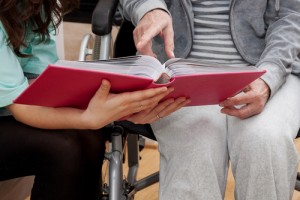
On Wednesday last, we posted about a survey of accessible websites. Today, we wanted to reflect on a piece in BJLD recently which looked at the history of the Plain Facts project.
As research is carried out into the lives of people with learning disabilities and on ways to improve the services that are offered to them, then people with disabilities need to be involved in setting the agenda for that research, be involved in its design and implementation and of course need to be able to get access to its results in the form of easy information summaries.
There has been a good deal of systemic change in the ways information has been provided, with the Department of Health for example now providing easy read summaries of all its major policy documents.
Plain Facts
This paper in BJLD reflected on the work of an employee of the Norah Fry Research Centre who has a learning disability, whose role over the years has been to help produce easy read summaries.
For many years, Norah Fry produced Plain Facts. Plain Facts was a magazine and tape for people with learning difficulties and their supporters. Each issue focused on the findings of a specific research project and used pictures and easy words to make information about research easier to understand.
But the findings of research are the end of a long process and the authors of this paper were keen also to point to the long history of inclusion of people with learning disabilities in the whole process of research.
More and more research is including the perspectives of people with learning disabilities, much of which is reflected in the posts on this site, but there is also an argument to suggest that such research should “spring directly from their own concerns,” and “should be as far as possible controlled by disabled people” (from this paper)
Our own site exists to enable the findings of research to made more accessible to practitioners to improve the impact of findings on practice. Norah Fry’s commitment as expressed in this paper is to ensure that research has the greatest impact on the end users – people with learning disabilities themselves, and they aim to do this by using accessible dissemination methods.
One of the interesting things to notice about the Plain Facts project was that as well as making findings more accessible through the use of easy words and pictures, the choice of topics was impacted on by people with disabilities and their concerns. The pilot phase of the project saw editions produced on topics which offered information on housing choices, help to find employment and making complaints about existing services.

As well as making findings more accessible, the choice of topics was impacted on by people with disabilities and their concerns
54 editions of Plain Facts were produced in all. As the project was funded by the Joseph Rowntree Foundation until 2005, projects covered were those funded by the Foundation.
Key to the process of producing Plain facts was the involvement of people with learning disabilities. Norah Fry employed an information officer with learning disabilities and the authors reflect on how critical his input was in, for example, choosing the right words to replace sometimes jargonistic phrases in research reports.
Accesible?
The central difficulty with the notion of accessible information though is of course that one person’s accessible is another person’s incomprehensible. The term learning disability covers a broad range of issues for individuals from people who may have reading skills through to people with profound intellectual impairments. In the context of person centred approaches to providing support, this would suggest that providing accessible information must be seen as a personalised process.
This would mean that ‘accessible’ information for all is an impossible outcome. This may well be the case, but the authors argue that to have a positive impact on the lives of people with more profound learning disabilities, therefore, family and close supporters most likely to understand individual communication needs must be empowered with access to information.
The authors describe their practical struggles with this dilemma over the years of producing Plain Facts and comment on the continued position of power of those on the Norah Fry team who did not have learning disabilities to make choices over what does and does not get included. They also comment on the notion of ‘concrete facts’ being the driver of what was reported on, which may have meant some of the subtleties of the findings were lost in the process of translation.

‘Concrete facts’ were the driver of what was reported on, some subtleties of findings were lost in the process of translation
Impact on people with learning disabilities
The question of whether the work to produce easy read information has impacted the lives of people with learning disabilities however is one that was put to the learning disabled information officer on the project. His response was a very personal one, which reflected more on the impact of the work he had done on his own decision making in his life – he was adamant though that the fact that Plain Facts was available for people to read together, to listen to on tape (or from staff members reading it aloud) meant that “When people talk together, they can connect the information with their own lives.”
In 2015 of course, video and the web are key tools in the dissemination of information. However, many people with learning disabilities are not confident in searching for material on the web and may not come across the kind of sites that offer information and advice.
As the authors point out, although easy-read texts may be a necessary step, they are not sufficient in themselves to ensure the comprehension of people with learning disabilities. However, technology opens up a whole range of opportunities – for example a recent development was a video of a Skype discussion with a researcher and writer of a journal article by the current paper’s authors.
New technologies – new opportunities
It seems clear that the opportunities offered by technology for broader engagement with research are many, but people with learning disabilities will need open minded, research connected supporters to help them to navigate the sea of research findings, make sense of what is being published and consider the potential impact on their lives and the decisions they want to make.

People with learning disabilities need open minded, research connected supporters to help them navigate the sea of findings
Links
Primary paper
Goodwin, J., Mason, V., Williams, V. and Townsley, R. (2015), Easy Information about research: getting the message out to people with learning disabilities. British Journal of Learning Disabilities, 43: 93–99 [abstract]
Other References
Plain Facts: A magazine and tape for people with learning difficulties

People with LD need open minded, research connected supporters to help them navigate the sea of findings http://t.co/yLMnbXk9gc
Don’t miss: Accessible research findings for people with learning disabilities http://t.co/yLMnbXk9gc #EBP
Understanding research – what does it mean for me? Accessible research findings for people with learning… http://t.co/mPCsYIsVCK
“Understanding research–what does it mean for me?Accessible research findings for people with learning disabilities” http://t.co/QnEwrmd6u6
How #easy2read format improves lives of people w/ intellectual #disabilities: http://t.co/WJ6KFODmJM #community4all http://t.co/UfYgBNma1U